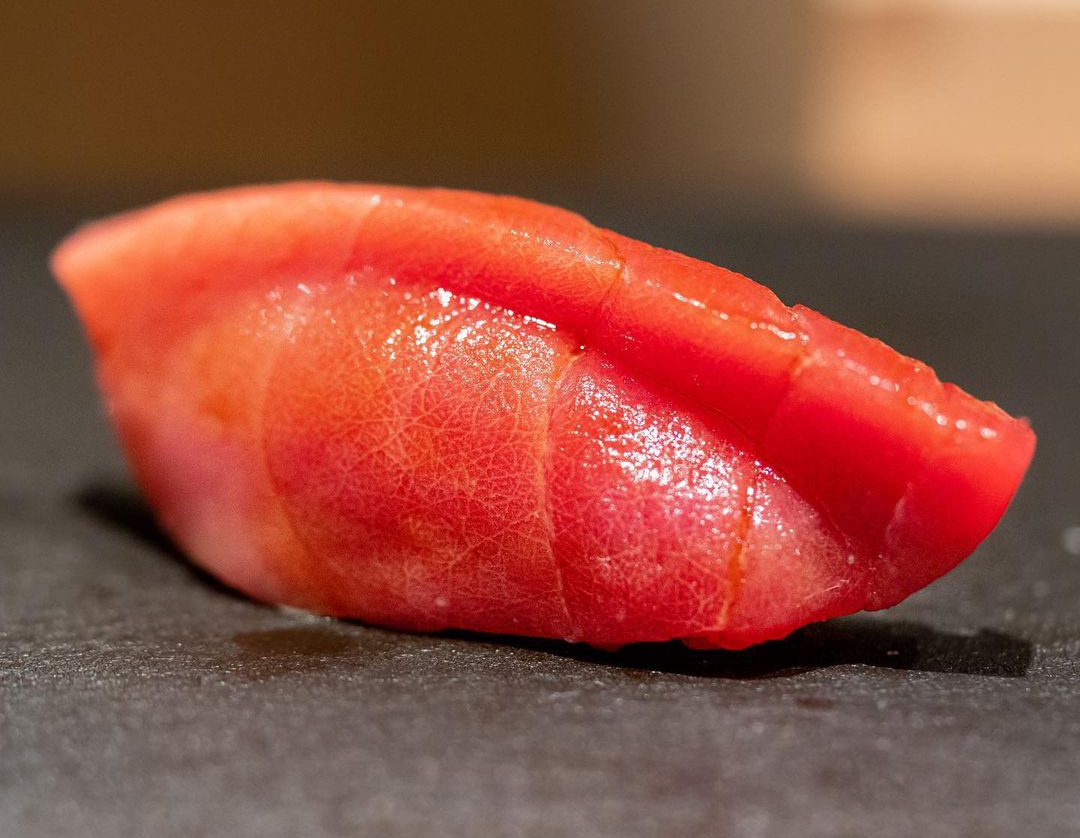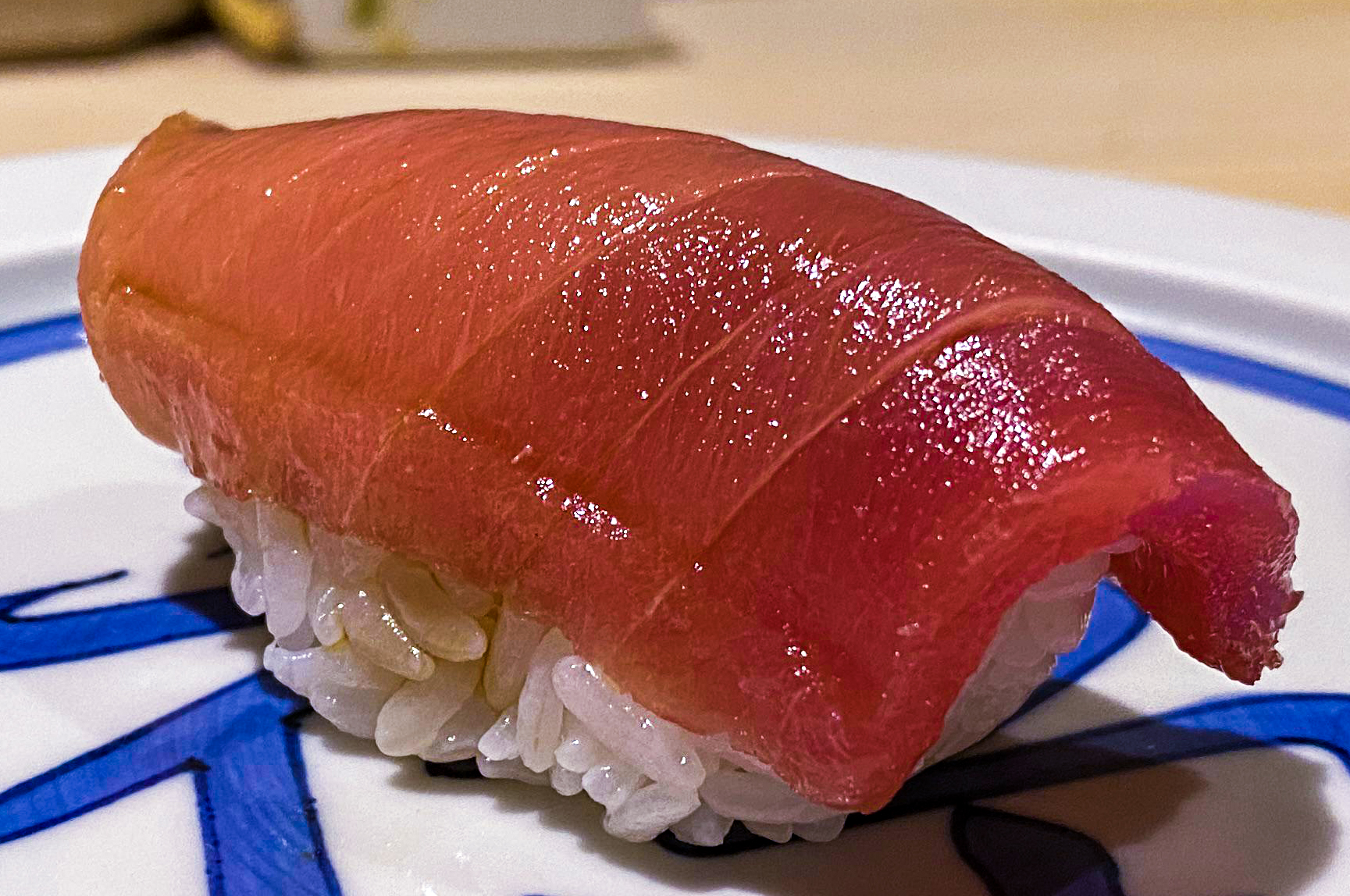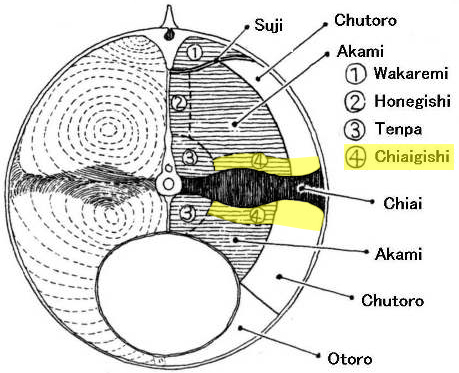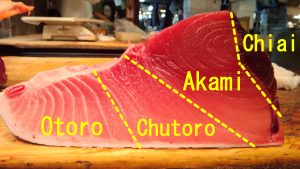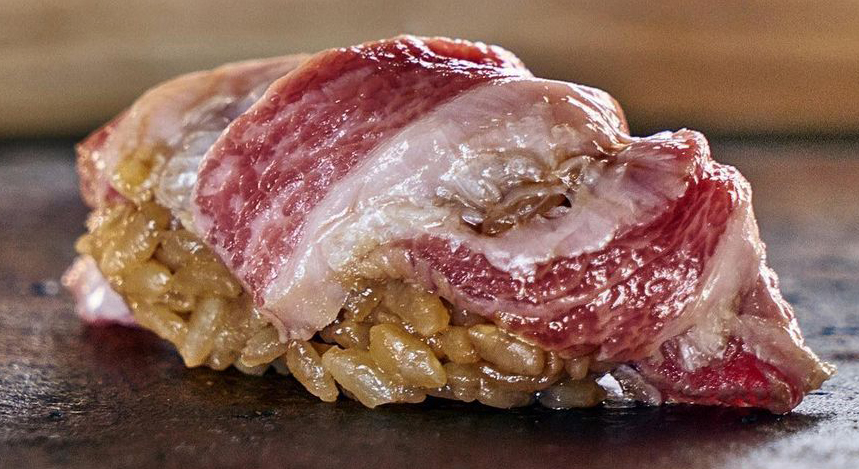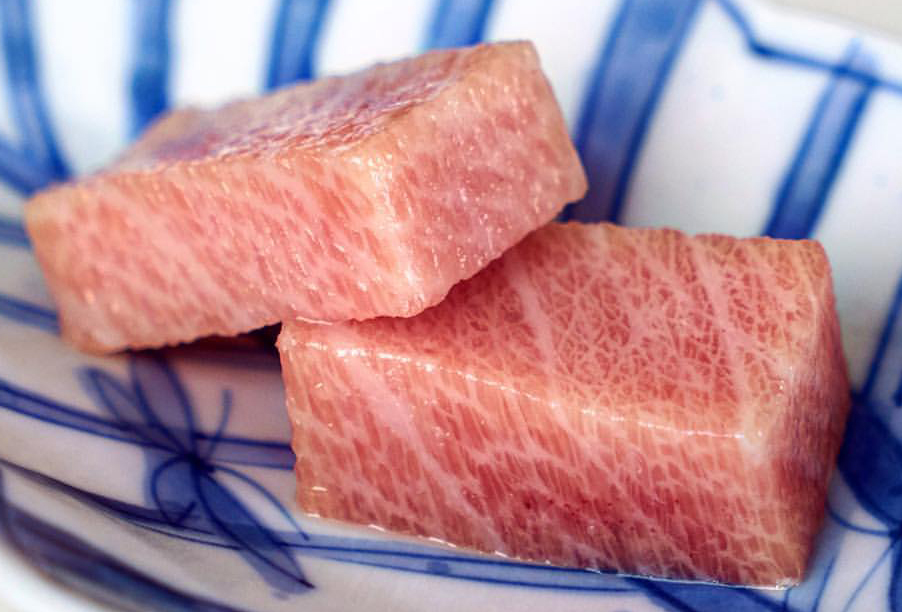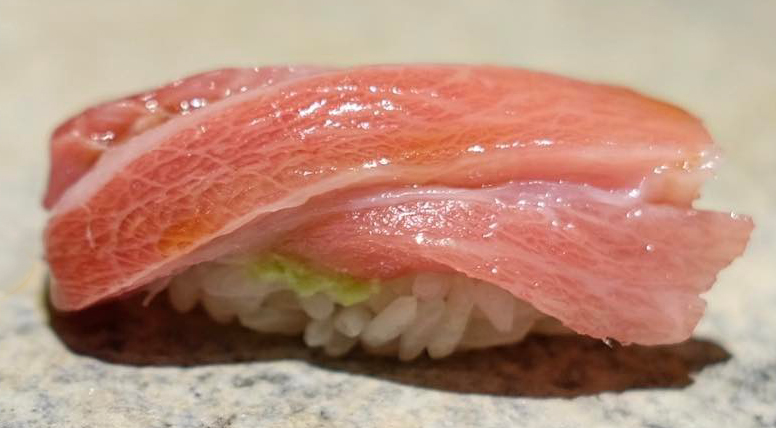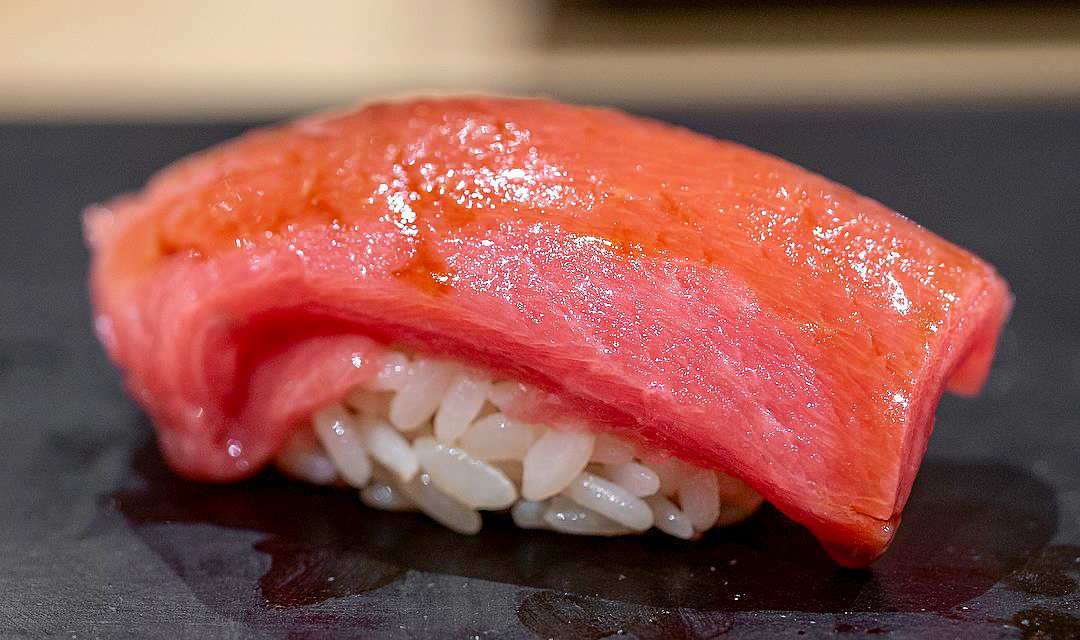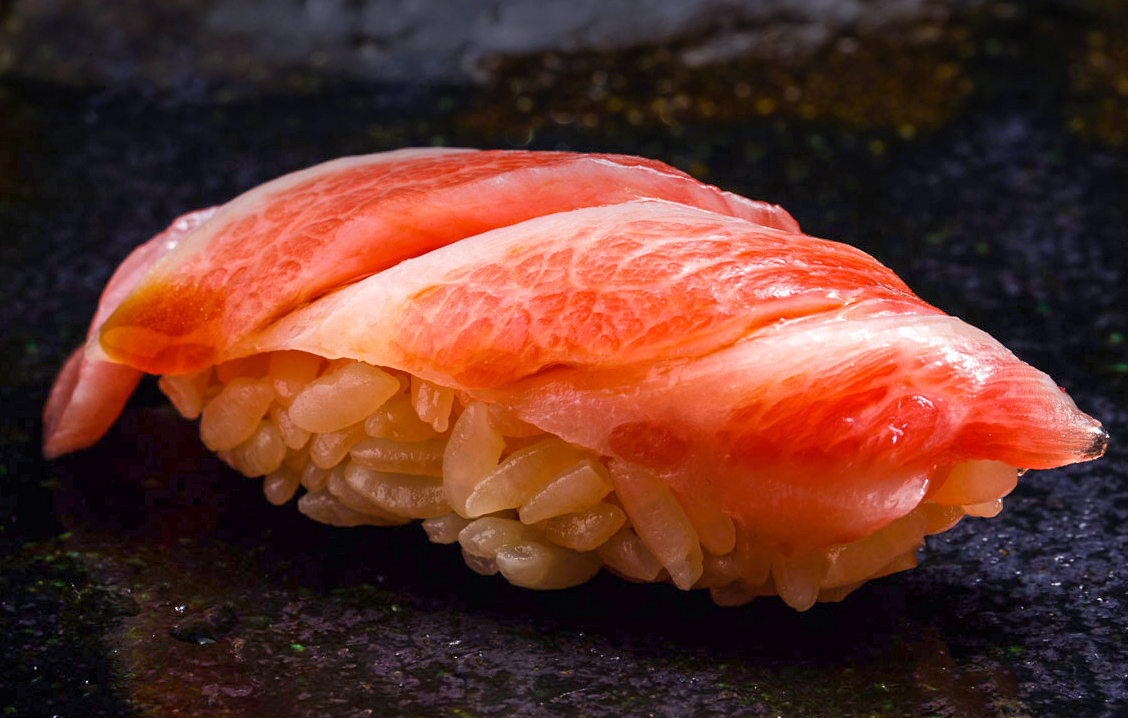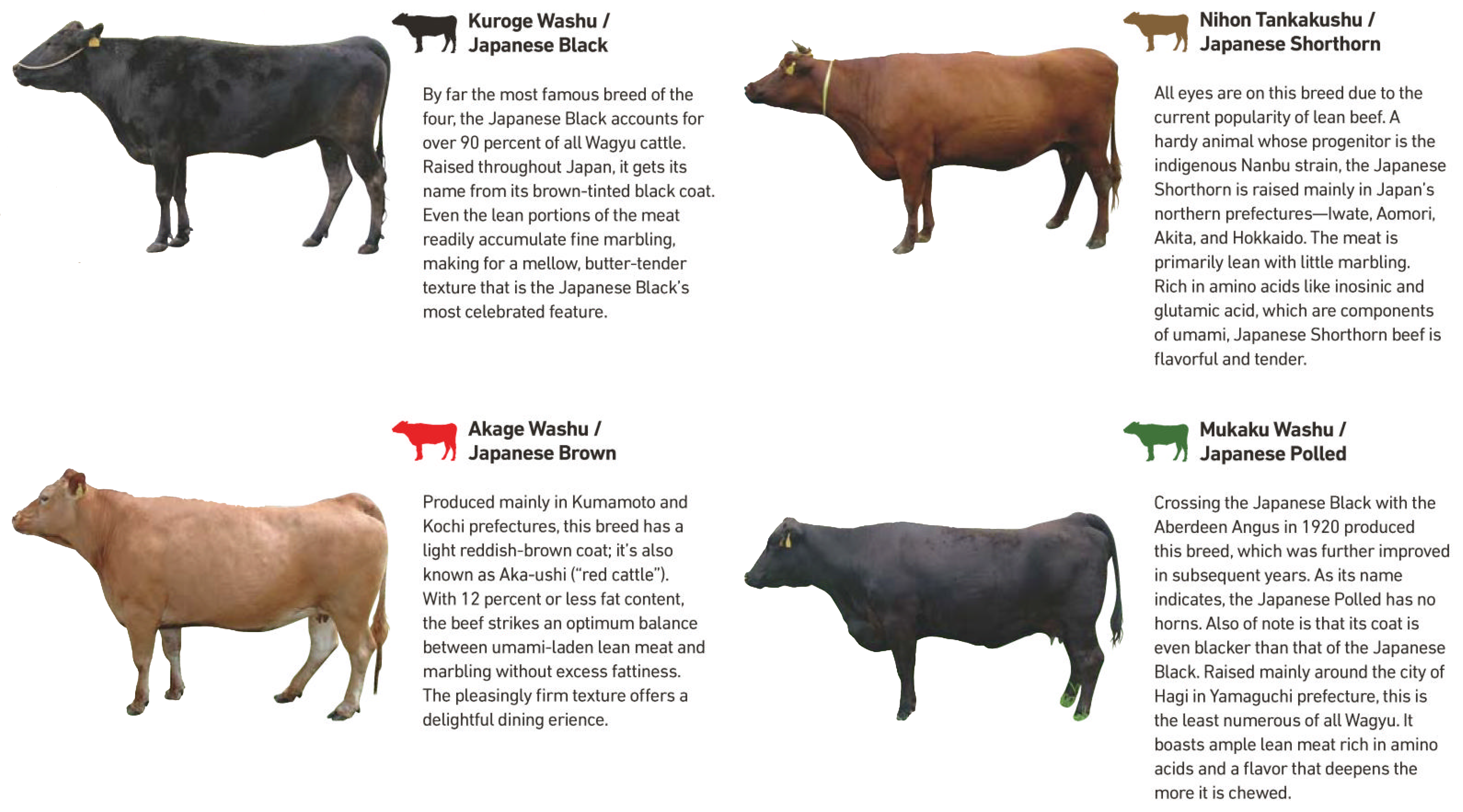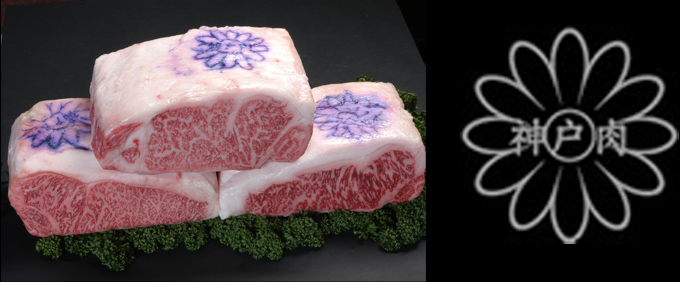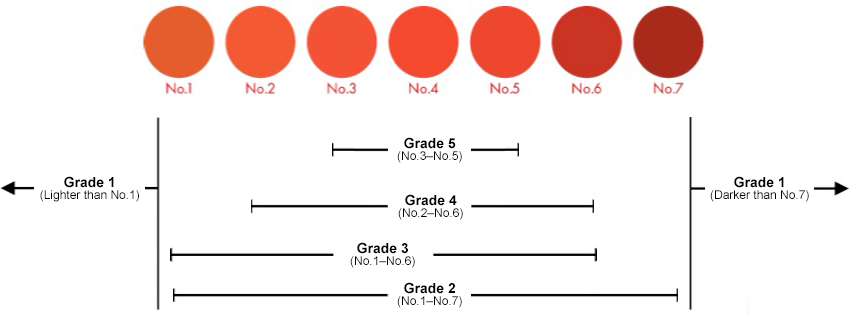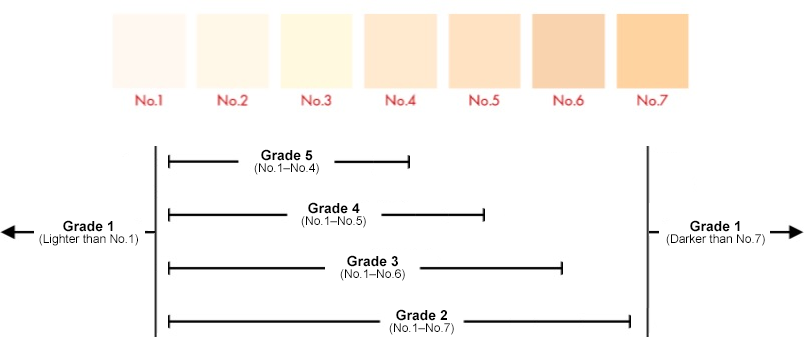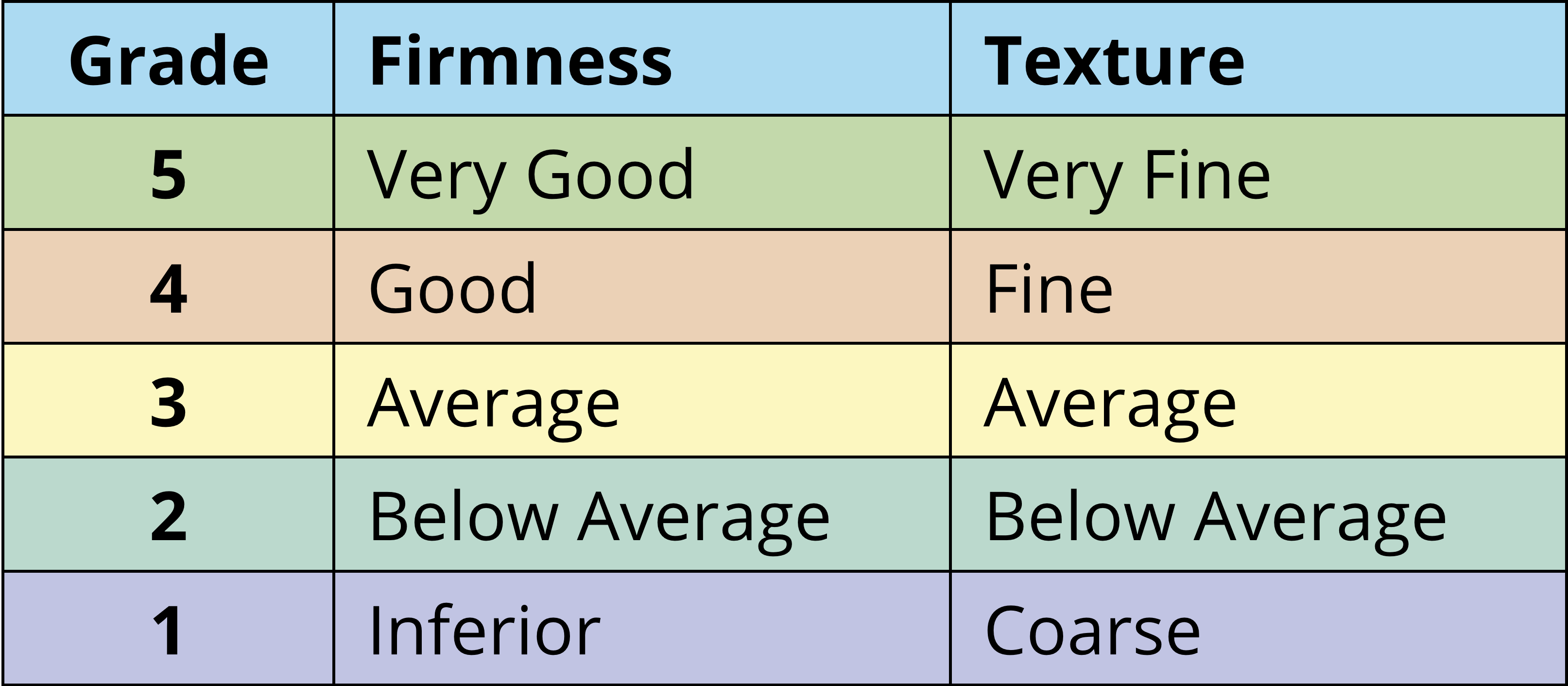Sushi & Wagyu Glossary
by Alex Evins (v.03/24)
|
Basics Neta/Tane – Fish Shari – Sushi rice, typically white rice with vinegar, sugar, and salt (More) Nigiri – Piece of sushi (neta + shari) Omakase – “I'll leave it to you,” the format of meals at high-end sushiya Otsumami/Tsumami – Small appetizers or snacks Sakana – Small drinking snacks Taisho – Head sushi chef, usually also the proprietor Itamae – “In front of the counter,” typically refers to an assistant sushi chef Sushiya/Sushi-yasan – Sushi shop or restaurant
Styles (More) Edomae – Traditional Tokyo-style sushi invented 200 years ago Ezomae – Hokkaido-style sushi showcasing seafood of Hokkaido's waters Kyshu-mae – Kyushu-style sushi that uses salt, kabosu, and shichimi in addition to soy sauce and tare; aka Kokura-mae Sosakuzushi – Creative sushi not limited by edomae rules and traditions
Preparations Aburi – Torched or seared Chirashizushi Bowl of rice, typically sumeshi, topped with scattered neta Bara-chirashi – Neta is cut into small pieces and mixed into the rice Kaisendon – Bowl of rice, typically plain rice, topped with neta Gunkan maki – Nigiri with nori wrapped around the rice Jukusei-gyo – Aged neta Kobujime – Curing of fish between layers of konbu Kurakake Maki – Sushi in rolled form Nitsuke – Simmered and marinated Oshizushi – Box pressed sushi (Types
Battera – Oshizushi made with vinegared mackerel (saba) Sujime – Pickling with salt and vinegar, softens tiny bones Temaki – Hand roll Temarizushi – Small ball-shaped nigiri Yubiki/Kawasimozukuri – Blanching by splashing fish with boiling water Zuke – Marinated
Ingredients Akazu – Red vinegar, from sake kasu, often used to season the shari Dashi – Cooking/soup base made from fish and seaweed Kabosu – Green Japanese citrus, used in Kyushu-mae sushi Komezu – Rice vinegar, used to season the shari Konbu – Edible kelp, often used as a base seasoning Nori – Dried seaweed, used for wrapping maki or gunkan Oboro – Crumbled sweet shrimp paste made using shiba-ebi Ponzu – Yuzu-based sauce served with sashimi Shicimi Togarashi – Seven spice mix incl. chilli, seaweed, and sesame Shio – Salt Shoyu – Soy sauce Nikiri – Sweetened soy sauce used for sushi; made from shoyu (tamari or koikuchi), mirin, sake, and konbu/bonito Sudachi – Small green Japanese citrus Tare – Seasoned soy sauce used for topping or basting Tsume/Nitsume – Eel sauce, a sweet soy-based sauce Umibudo – Sea grapes, used in Kyushu-mae sushi Wasabi – Horseradish-like rhizome grated into a paste for seasoning Yuzu – Small yellow Japanese citrus
White Fish (Shiromi) Lean White Fish Fugu – Blowfish Hirame – Fluke Engawa – Fluke or flounder fin Isaki – Grunt Aka-isaki – Red Grunt Karei – Flounder, aka Japanese flatfish Abura-karei – Kamchatka flounder Hoshi-karei – Starry flounder, prized Madara – Pacific cod Mako-karei – Marbled flounder Matsukawa-karei – Barfin flounder Mishima-okoze – Japanese stargazer Same-karei – Shark flounder, aka roughscale sole Kawahagi – Thread-sail filefish, often served with its liver Kochi – Flathead Mahata/Hata – Grouper, aka rock cod Aka-hata – Red grouper, aka blacktip grouper Ao-hata – Yellow grouper Houki-hata – Comet grouper, found in Ise Suzuki – Sea bass Seigo – Young sea bass Usubahagi – Unicorn leatherjacket Medium–Full Bodied White Fish Ainame – Fat greenling, very rare Amadai – Tilefish Aka-amadai – Red or horsehead tilefish Shiro-amadai – White tilefish Hakkaku – Dragon fish, aka sailfin poacher Hamachi – Yellowtail, goes by different names depending on age/size (Wakashi → Inada → Warasa → Buri) Buri – Adult yellowtail Kanburi – Winter yellowtail, fattier; from Toyama Bay in Himi Hiramasa – Yellowtail amberjack Hobo – Spiny red gurnard, very rare Ibodai – Japanese butterfish Ishidai – Striped beakfish, aka barred knifejaw Kanpachi – Greater amberjack, not baby yellowtail Kisu – Japanese whiting Kue/Ara – Longtooth grouper Nodoguro – Adult rosy seabass, aka blackthroat seaperch Aka-mutsu – Young nodoguro Kuromutsu – Japanese bluefish Shima-aji – Striped jack Soi - Rockfish Kinki – Thornyhead rockfish Kurosoi – Black rockfish Tai – Sea bream or snapper
(Less Common Types
Ebisudai/Yoroidai – Japanese soldierfish Aka-amadai – Red sea bream Aodai – Blue sea bream, aka Japanese snapper Itoyoridai – Golden threadfin bream Kidai – Yellowback sea bream Kinmedai – Golden eye snapper Kurodai – Black snapper Madai – Japanese red sea bream, aka Pacific barrelfish Sakuradai – Cherry blossom sea bream Takabe – Yellow-striped butterfish
Silver-Skinned Fish (Hikari Mono) Aji – Horse mackerel Iwashi – Sardine Kaiwari – White fin trevally Kamasu – Barracuda Kasugo – Young crimson sea bream Kibinago – Silver-stripe round herring Kisu – Japanese whiting Kohada – Gizzard shad; indicator of skill Shinko – Baby kohada Managatsuo – Butterfish, aka silver pomfret Mehikari – Greeneye Nishin – Pacific herring Saba – Mackerel Goma-saba – Blue mackerel Nama-saba – Raw mackerel Shime-saba – Cured mackerel Sanma – Pacific saury, aka pike mackerel Sawara – Spanish mackerel Sagoshi – Young Spanish mackerel Sayori – Needlefish, aka Japanese halfbeak Kannuki – Large needlefish Tachiuo – Beltfish
Long Fish (Nagamono) Anago – Salt-water conger eel Noresore – Baby conger eel Hamo – Conger pike eel Unagi – Freshwater eel, not used in sushi Yagara – cornetfish Aka-yagara – Red cornetfish
Inkfish Ika – Squid Aori-ika – Bigfin reef squid Hotaru-ika – Firefly squid Sumi-Ika – Cuttlefish, most common Kaminari-Ika/Mongo-Ika– Kisslip cuttlefish Shin-Ika – Baby cuttlefish Yari-ika – Spear Squid Tako – Octopus Mizudako – Giant Pacific Octopus Namadako – Raw Octopus Yudedako – Boiled Octopus Takowasa – Sakana made of boiled sliced octopus with wasabi |
|
Red-Fleshed Fish (Akami) Katsuo – Bonito, aka skipjack tuna Suma – Black skipjack Maguro – Tuna Binnaga-maguro/Bincho-maguro/Shiro-maguro – Albacore tuna Koshinaga-maguro – Longtail tuna Kihada-maguro – Yellowfin tuna (aka Ahi tuna) Mebachi/Bachi-maguro – Big-eye tuna (aka Ahi tuna) Minami-maguro – Southern bluefin tuna Kuro-maguro/Hon-maguro – Pacific (taiheiyou) or Atlantic (taisaiyou) bluefin tuna Chiai– Dark red bloody meat, rarely used in sushi Chiai-gishi Akami – Lean meat from the upper- (sekami) or, preferably, mid-back (senaka) Akami zuke – Marinated akami Toro – Fatty meat Chutoro – Medium-fatty cut from the mid-belly (haranaka) or back (sekami/senaka) Otoro – Fatty cut, typically from the upper belly (harakami) Kamatoro – Very fatty marbled cut from the back cheek Dandara Shimofuri Sunazuri Hagashi Toro Jabara Toro Kawagishi Toro – Describes meat that is scraped from the bone or skin Negitoro – Finely chopped fatty tuna commonly mixed with scallions Setoro – Meat from the back area closest to the dorsal fin, a type of wakaremi Noten/Hachinomi – Meat from the top of the head Tossaki – Meat from the base of the head Hohoniku – Cheek meat from below the eye, often grilled Nakaochi – Tuna rib Nakaochi Scrape – Tuna rib/back meat scraped off from the bones Tenpa/Tenmi – Lean meat from near the spine Wakaremi – Meat found at the root of the dorsal fin, very rare Onomi – Meat from the tail/dorsal fin Hireshita – Scraped meat from right above the first pectoral fin Suji – Tuna tendon, can be grilled and eaten Meji – Baby bluefin tuna, < 1 year old Chubo – Young bluefin tuna, 2–5 years old
Shellfish (Kairui) Akagai – Ark–shell clam, aka red clam Himo – Mantle around the meat of the clam Aoyagi – Red clam or orange clam Awabi – Abalone; often served with its own liver sauce Hamaguri – Hard clam Hashira – Shellfish adductor muscle Hokkigai – Surf clam Hotate – Scallop Ishigakigai – Aleutian cockle Kaibashira/Kobashira – Adductor muscle, sometimes referred to as baby scallops Kaki – Oyster Mategai – Razor clam Mirugai – Giant clam or geoduck Sazae – Horned turban shell Tairagai – Pen shell, similar in consistency to scallops Torigai – Japanese cockle Tsubugai – Whelk
Crustaceans (Kokakurui) Ebi – Shrimp Aka-ebi – Argentine red shrimp Ama-ebi – Sweet shrimp Ao-ebi – Blue shrimp from New Caledonia; not sold in Japan Botan-ebi/Toyama-ebi – Spot prawn Budo-ebi/Higoromo-ebi – Grape shrimp from Hokkaido and Sanriku Gasu-ebi – Rustling sweet shrimp found mainly in Kanazawa Ise-ebi/Oni-ebi/Ibaramo-ebi – Spiny lobster Kuma-ebi – Green tiger prawn Kuruma-ebi – Japanese tiger prawn Odori-ebi – “Dancing shrimp,” preparation where shrimp are served live Sakura-ebi – Tiny pink shrimp Shako/Gasa-ebi – Mantis shrimp Shiba-ebi/Himeama-ebi – Small grey prawn Shima-ebi – Hokkai shrimp, aka Morotoge or striped shrimp Shiro-ebi – Small white shrimp Ushi-ebi – Giant/black tiger prawn Kani – Crab (Other Crab Species
Snow Crab (Opilio/Bairdi - Worldwide) Abura-gani – Blue king crab Hanasaki-gani – Hanasaki crab, a red spikey king crab from Nemuro Kani-miso – Crab brain and innards Ke-gani – Hokkaido hairy crab, aka horsehair crab Mokuzu-gani – Japanese mitten crab Sawa-gani – Japanese freshwater crab Taraba-gani – Red king crab Takaashi-gani – Japanese spider crab Watari-gani/Gazami – Japanese blue/swimming crab Zuwai-gani – Snow crab, has verious names based on the region of origin Benizuwai-gani – Red snow crab Kogane-gani – Golden snow crab from Fukui Matsuba-gani/Kano-gani – Male snow crab, “pine-leaf crab” Seko-gani/Koppe-gani – Femal snow crab Kobako-gani – Prized “flavor box” female snow crab from Kanazawa Taiza-gani – Very rare snow crabs from Taiza port in Kyoto
Roe (Gyoran) Ikura – Salmon roe Sujiko – Ikura in it’s sac Karasumi – Dried and cured mullet roe, softer version of bottarga Borako – Fresh mullet roe Kazunoko – Herring roe, often dried and pressed into blocks Kimo – Liver, often served as a otsumami or as a topping/sauce Ankimo – Monkfish liver Shirako – Cod sperm sacs Shiokara – Sakana made of fermented squid entrails Sotoko – Crab roe Tarako – Salted sacks of cod roe, not typically used in sushi Mentaiko/Karashi Mentaiko – Tarako from Alaska pollack seasoned with chili Uni – Sea urchin gonads
(Species
Japanese: Aka uni – Pink/red sea urchin, short spines, found off of Kyushu Bafun uni – Green sea urchin, short spines, darker colored flesh, found in deep waters off Honshu Ezo-bafun uni – Prized bafun uni from Hokkaido Murasaki uni – Purple sea urchin, longer spines, larger lighter colored flesh, found in the waters off Honshu Kita-Murasaki uni – Prized murasakai uni from Hokkaido Shirahige uni – White collector uni, found in the waters around Okinawa Non-Japanese California – American purple (American murasaki) and American giant purple/red (American omurasaki) Maine – Northern green (Northern bafun) Caribbean – American white (American shiro) Chilean – Chilean red (Chiri-uni) European – European purple (European murasaki)
Note that the colors above typically refer to their exterior and that uni is also broadly categorized based on the color of its flesh as either Shiro (“white”) uni (lighter yellow type from purple/Murasaki species) or Aka (“red”) uni (darker yellow type from green/Bafun species; higher quality).
Other Gari – Sliced pickled ginger, served as a palate cleanser between nigiri Tamago – Sweet egg omelette served at the end of a meal; indicator of skill
Other Common Fish Not Typically Used in Sushi Ayu – Sweetfish Gindara – Black cod, aka sablefish Kujira – Whale Masu – Trout Niji-masu – Rainbow trout Sakura-masu – Cherry blossom trout Amago – Red spotted trout Satsuki-masu – Rain salmon;seagoing variety of amago Biwa-masu – Sakura-masu from Lake Biwa Umi-masu – Ocean trout Oome-masu – See Tokishirazu (Sanriku) Sake – Salmon Masunosuke – King salmon Shiozake – Chum (dog) salmon Tokishirazu/Tokizake – Rare young shiozake caught in the spring/summer Keiji – Rare young shiozake caught in the fall Benizake – Red (sockeye) salmon Ginzake – Silver (coho) salmon Karafutomasu – Pink (humpback) salmon Shirauo – Japanese icefish, aka whitebait Shishamo – Willow leaf fish, a type of smelt Tobiuo – Flying fish Tobiko – Flying fish roe, artifically colored Other
Akasita – Red tonguefish |
|
Wagyu Glossary Wagyu is Japanese (wa-) beef (-gyu) from any of the below four Japanese breeds of beef cattle
Japanese Black (Kuroge Washu) [> 90% of wagyu, breed known for its marbling] Tajima Ushi – Bloodline of Kuroge Washu mainly from Hyogo Prefecture Kobe-gyu – Famed and prized Kobe beef from Hyogo, must have the iconic Nojigiku stamp Hida-gyu – Prized beef raised in the Fukano Valley of Gifu Prefecture Matsusaka-gyu – Famed beef of heifers (females that have not borne calves) from Mie Prefecture Ōmi-gyu – Famed beef from Shiga Prefecture east of Kyoto, older strain than Kobe-gyu Sanda-gyu – Very rare, from Sanda City in Hyogo Other Popular Ushi Miyazaki-gyu – Highly prized beef from Kyushu, second largest Japanese Black producer Ozaki Beef – Prized wagyu from Muneharu Ozaki’s farm in Miyazaki; supplier of WAGYUMAFIA Hitachi-gyu – Hand-raised cattle from Ibaraki Prefecture Iga-gyu – Very rare, heifers from Mie Prefecture Iwami-gyu – Famed and rare, heifers from Ōnan in Shimane Prefecture Kagoshima-gyu – Prized beef from Kyushu, south of Miyazaki, largest Japanese Black producer Kazusa-gyu – Raised on iodine-rich water in Chiba Prefecture Maesawa-gyu – From Iwate Prefecture, raised on straw from the same ward of Oshu city Noto-gyu – Very rare marbled meat from Ishikawa Prefecture Sanuki-gyu – Olive wagyu, prized newer strain raised on olives from Shodoshima Island in Kagawa Prefecture Shinshu-gyu – Very rare, raised on Apples, from Nagano Prefecture Shiro-gyu – Prized and rare, from Hokkaido Saga-gyu – Crossbreed between Japanese Black and Holstein dairy cows from Saga Prefecture Yonezawa-gyu – Famed beef of heifers from Yamagata Prefecture
Japanese Red/Brown (Akage Washu/Kassyoku Washu) Aka-gyu – Leaner meat mainly from Kumamaoto and Kochi
Japanese Shorthorn (Tankaku Ushu) [< 1% of all wagyu] Iwate Tankaku-gyu – Leaner meat from Iwate
Japanese Polled (Mukaku Washu) [Virtually nonexistant due to conservation efforts]
Note that “washu” means “Japanese breed” and should not be confused with the American product Washugyu, which is a crossbreed between Tajima-ushi and American Black Angus, similar to other types of so-called “American Wagyu.” For comparison, USDA Prime has a BMS score of 3–5. For more, see Wagyu Myths Debunked.
Wagyu Grading Yield Grade – Letter grade (A to C, A being the best) indicating amount of meat yielded from the cow; not a quality grade Meat Quality Score – Number score (1 to 5, 5 being the best) based on the lowest of the following scores: BMS – Beef Marbling Standard, score for fat (Grade 5 = BMS 8–12 BCS – Beef Color Standard, score for meat color (Grade 5 = BCS 3–5 BFS – Beef Fat Standard, score for fat color (Grade 5 = BFS 1–4 Texture/Firmness – Visually appraised score for texture (Grade 5 = Very Fine Texture and Very Good Firmness Thus, top grade wagyu is labeled A5 |
|
Red-Fleshed Fish (Akami) Katsuo – Bonito, aka skipjack tuna Suma – Black skipjack Maguro – Tuna Binnaga-maguro/Bincho-maguro/Shiro-maguro – Albacore tuna Koshinaga-maguro – Longtail tuna Kihada-maguro – Yellowfin tuna (aka Ahi tuna) Mebachi/Bachi-maguro – Big-eye tuna (aka Ahi tuna) Minami-maguro – Southern bluefin tuna Kuro-maguro/Hon-maguro – Pacific (taiheiyou) or Atlantic (taisaiyou) bluefin tuna Chiai– Dark red bloody meat, rarely used in sushi Chiai-gishi Akami – Lean meat from the upper- (sekami) or, preferably, mid-back (senaka) Akami zuke – Marinated akami Toro – Fatty meat Chutoro – Medium-fatty cut from the mid-belly (haranaka) or back (sekami/senaka) Otoro – Fatty cut, typically from the upper belly (harakami) Kamatoro – Very fatty marbled cut from the back cheek Dandara Shimofuri Sunazuri Hagashi Toro Jabara Toro Kawagishi Toro – Describes meat that is scraped from the bone or skin Negitoro – Finely chopped fatty tuna commonly mixed with scallions Setoro – Meat from the back area closest to the dorsal fin, a type of wakaremi Noten/Hachinomi – Meat from the top of the head Tossaki – Meat from the base of the head Hohoniku – Cheek meat from below the eye, often grilled Nakaochi – Tuna rib Nakaochi Scrape – Tuna rib/back meat scraped off from the bones Tenpa/Tenmi – Lean meat from near the spine Wakaremi – Meat found at the root of the dorsal fin, very rare Onomi – Meat from the tail/dorsal fin Hireshita – Scraped meat from right above the first pectoral fin Suji – Tuna tendon, can be grilled and eaten Meji – Baby bluefin tuna, < 1 year old Chubo – Young bluefin tuna, 2–5 years old Makajiki – Striped marlin
Shellfish (Kairui) Akagai – Ark–shell clam, aka red clam Himo – Mantle around the meat of the clam Aoyagi – Red clam or orange clam Awabi – Abalone; often served with its own liver sauce Hamaguri – Hard clam Hashira – Shellfish adductor muscle Hokkigai – Surf clam Hotate – Scallop Kaibashira/Kobashira – Adductor muscle, sometimes referred to as baby scallops Kaki – Oyster Ishigakigai – Aleutian cockle Mategai – Razor clam Mirugai – Giant clam or geoduck Sazae – Horned turban shell Tairagai – Pen shell, similar in consistency to scallops Torigai – Japanese cockle Tsubugai – Whelk
Crustaceans (Kokakurui) Ebi – Shrimp Aka-ebi – Argentine red shrimp Ama-ebi – Sweet shrimp Ao-ebi – Blue shrimp from New Caledonia; not found in Japan Botan-ebi/Toyama-ebi – Spot prawn Budo-ebi/Higoromo-ebi – Grape shrimp from Hokkaido and Sanriku Gasu-ebi – Rustling sweet shrimp found mainly in Kanazawa Ise-ebi/Oni-ebi/Ibaramo-ebi – Spiny lobster Kuma-ebi – Green tiger prawn Kuruma-ebi – Japanese tiger prawn Odori-ebi – “Dancing shrimp,” preparation where shrimp are served live Sakura-ebi – Tiny pink shrimp Shako/Gasa-ebi – Mantis shrimp Shiba-ebi/Himeama-ebi – Small grey prawn Shima-ebi – Hokkai shrimp, aka Morotoge or striped shrimp Shiro-ebi – Small white shrimp Ushi-ebi – Giant/black tiger prawn Kani – Crab (Other Crab Species
Snow Crab (Opilio/Bairdi - Worldwide) Abura-gani – Blue king crab Hanasaki-gani – Hanasaki crab, a red spikey king crab from Nemuro Kani-miso – Crab brain and innards Ke-gani – Hokkaido hairy crab, aka horsehair crab Mokuzu-gani – Japanese mitten crab Sawa-gani – Japanese freshwater crab Taraba-gani – Red king crab Takaashi-gani – Japanese spider crab Watari-gani/Gazami – Japanese blue/swimming crab Zuwai-gani – Snow crab, has verious names based on the region of origin Benizuwai-gani – Red snow crab Kogane-gani – Golden snow crab from Fukui Matsuba-gani/Kano-gani – Male snow crab, “pine-leaf crab” Seko-gani/Koppe-gani – Femal snow crab Kobako-gani – Prized “flavor box” female snow crab from Kanazawa Taiza-gani – Very rare snow crabs from Taiza port in Kyoto
Roe (Gyoran) Ikura – Salmon roe Sujiko – Ikura in it’s sac Karasumi – Dried and cured mullet roe, softer version of bottarga Borako – Fresh mullet roe Kazunoko – Herring roe, often dried and pressed into blocks Kimo – Liver, often served as a otsumami or as a topping/sauce Ankimo – Monkfish liver Shirako – Cod sperm sacs Shiokara – Sakana made of fermented squid entrails Sotoko – Crab roe Tarako – Salted sacks of cod roe, not typically used in sushi Mentaiko/Karashi Mentaiko – Tarako from Alaska pollack seasoned with chili Uni – Sea urchin gonads
(Species
Japanese: Aka uni – Pink/red sea urchin, short spines, found off of Kyushu Bafun uni – Green sea urchin, short spines, darker colored flesh, found in deep waters off Honshu Ezo-bafun uni – Prized bafun uni from Hokkaido Murasaki uni – Purple sea urchin, longer spines, larger lighter colored flesh, found in the waters off Honshu Kita-Murasaki uni – Prized murasakai uni from Hokkaido Shirahige uni – White collector uni, found in the waters around Okinawa Non-Japanese California – American purple (American murasaki) and Maine – Northern green (Northern bafun) Caribbean – American white (American shiro) Chilean – Chilean red (Chiri-uni) European – European purple (European murasaki)
Note that the colors above typically refer to their exterior and that uni is also broadly categorized based on the color of its flesh as either Shiro (“white”) uni (lighter yellow type from purple/Murasaki species) or Aka (“red”) uni (darker yellow type from green/Bafun species; higher quality).
Other Gari – Sliced pickled ginger, served as a palate cleanser between nigiri Tamago – Sweet egg omelette served at the end of a meal; indicator of skill
Other Common Fish Not Typically Used in Sushi Ayu – Sweetfish Gindara – Black cod, aka sablefish Kujira – Whale Masu – Trout Niji-masu – Rainbow trout Sakura-masu – Cherry blossom trout Amago – Red spotted trout Satsuki-masu – Rain salmon;seagoing variety of amago Biwa-masu – Sakura-masu from Lake Biwa Umi-masu – Ocean trout Oome-masu – See Tokishirazu (Sanriku) Sake – Salmon Masunosuke – King salmon Shiozake – Chum (dog) salmon Tokishirazu/Tokizake – Rare young shiozake caught in the spring/summer Keiji – Rare young shiozake caught in the fall Benizake – Red (sockeye) salmon Ginzake – Silver (coho) salmon Karafutomasu – Pink (humpback) salmon Shirauo – Japanese icefish, aka whitebait Shishamo – Willow leaf fish, a type of smelt Tobiuo – Flying fish Tobiko – Flying fish roe, artifically colored Other
Akasita – Red tonguefish |
